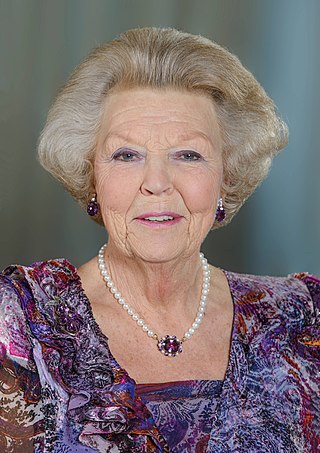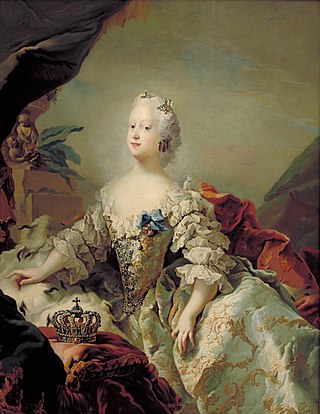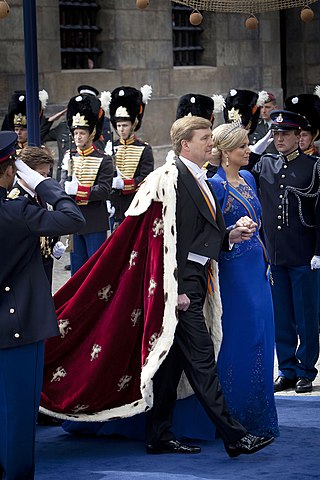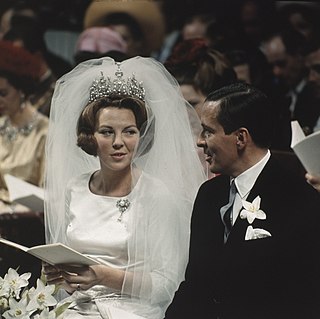
The House of Orange-Nassau is the current reigning house of the Netherlands. A branch of the European House of Nassau, the house has played a central role in the politics and government of the Netherlands and elsewhere in Europe, particularly since William the Silent organised the Dutch Revolt against Spanish rule, which after the Eighty Years' War (1568–1648) led to an independent Dutch state. William III of Orange led the resistance of the Netherlands and Europe to Louis XIV of France, and orchestrated the Glorious Revolution in England that established parliamentary rule. Similarly, Queen Wilhelmina of the Netherlands was instrumental in the Dutch resistance during World War II.

Juliana was Queen of the Netherlands from 1948 until her abdication in 1980.

Beatrix is a member of the Dutch royal house who reigned as Queen of the Netherlands from 1980 until her abdication in 2013.

Willem-Alexander is King of the Netherlands.

Wilhelmina was Queen of the Netherlands from 1890 until her abdication in 1948. She reigned for nearly 58 years, making her the longest-reigning monarch in Dutch history, as well as the longest-reigning female monarch outside the United Kingdom. Her reign saw World War I, the Dutch economic crisis of 1933 and World War II.

Princess Margriet of the Netherlands is the third daughter of Queen Juliana and Prince Bernhard. As an aunt of the reigning monarch, King Willem-Alexander, she is a member of the Dutch Royal House and currently eighth and last in the line of succession to the throne.

A dynasty is a sequence of rulers from the same family, usually in the context of a monarchical system, but sometimes also appearing in republics. A dynasty may also be referred to as a "house", "family" or "clan", among others.

A speech from the throne, or throne speech, is an event in certain monarchies in which the reigning sovereign, or their representative, reads a prepared speech to members of the nation's legislature when a session is opened. The address sets forth the government's priorities for its legislative agenda, for which the cooperation of the legislature is sought. The speech is often accompanied by formal ceremony. It is often held annually, although in some places it may occur more or less frequently, whenever a new session of the legislature is opened.

A queen regnant is a female monarch, equivalent in rank, title and position to a king. She reigns suo jure over a realm known as a kingdom; as opposed to a queen consort, who is married to a reigning king; or a queen regent, who is the guardian of a child monarch and rules pro tempore in the child's stead or instead of her husband who is absent from the realm, be it de jure in sharing power or de facto in ruling alone. A queen regnant is sometimes called a woman king. A princess regnant is a female monarch who reigns suo jure over a principality; an empress regnant is a female monarch who reigns suo jure over an empire.

Louis Ferdinand, Prince of Prussia was a member of the princely House of Hohenzollern, which occupied the Prussian and German thrones until the abolition of those monarchies in 1918. He was also noteworthy as a businessman and patron of the arts.

Louise of Great Britain was Queen of Denmark and Norway from 1746 until her death, as the first wife of King Frederick V. She was the youngest surviving daughter of King George II of Great Britain and Caroline of Ansbach.
A queen mother is a former queen, often a queen dowager, who is the mother of the reigning monarch. The term has been used in English since the early 1560s. It arises in hereditary monarchies in Europe and is also used to describe a number of similar yet distinct monarchical concepts in non-European cultures around the world. The rank does not go to all mothers of monarchs though. A mother of a ruling monarch may only be referred to as Queen Mother if she was a Queen Consort as opposed to a Princess Consort.

Abdication is the act of formally relinquishing monarchical authority. Abdications have played various roles in the succession procedures of monarchies. While some cultures have viewed abdication as an extreme abandonment of duty, in other societies, abdication was a regular event and helped maintain stability during political succession.

There are 12 monarchies in the Americas, being either sovereign states or self-governing territories that have a monarch as head of state. Each is a constitutional monarchy, wherein the monarch inherits his or her office according to law, usually keeping it until death or abdication, and is bound by laws and customs in the exercise of their powers. Ten of these monarchies are part of the global personal union known as the Commonwealth realms and share Charles III, who resides in the United Kingdom, as king. The other two are the Monarchy of the Netherlands which is used in states of the Dutch Caribbean, and the Monarchy of Denmark which is used in Greenland. As such, none of the monarchies in the Americas have a permanently residing monarch, though the Commonwealth realms each have a resident governor-general to represent King Charles III and perform most of his constitutional duties in his name; and a high commissioner represents the King of Denmark and the Danish government in Greenland. Additionally, each of Canada's 10 provinces functions as a subnational constituent monarchy, with the constitutional powers vested in the King exercised at the provincial level by a lieutenant governor.

The monarchy of the Netherlands is a constitutional monarchy whose role and position are governed by the Constitution of the Netherlands. Roughly a third of the Constitution explains the succession, mechanisms of accession and abdication to the throne, the roles and duties of the monarch, the formalities of communication between the States General of the Netherlands, and the monarch's role in creating laws.

Coronations were previously held in the monarchies of Europe. The United Kingdom is the only monarchy in Europe that still practises coronation. Other European monarchies have either replaced coronations with simpler ceremonies to mark an accession or have never practised coronations. Most monarchies today only require a simple oath to be taken in the presence of the country's legislature.

Upon his or her accession to the throne, the new Dutch monarch undergoes an inauguration ceremony as required by the constitution. The ceremony is taken as a joint session of the two houses of the States General, and is held at the Nieuwe Kerk in Amsterdam.

The inauguration of Willem-Alexander took place on 30 April 2013 at the Nieuwe Kerk in Amsterdam. Willem-Alexander ascended the throne immediately following the abdication of his mother Queen Beatrix earlier that day. Willem-Alexander is the first King of the Netherlands since the death of his great-great-grandfather William III in 1890.

The wedding of Princess Beatrix of the Netherlands and Claus van Amsberg took place on Thursday, 10 March 1966, in Amsterdam, Netherlands. They were married first in a civil ceremony at the Prinsenhof, after which the marriage was religiously blessed in the Westerkerk. The bride was the eldest daughter of Queen Juliana and heir presumptive to the Dutch throne. The groom was an untitled German nobleman. The engagement of the future queen to a German caused an uproar among some Dutch people and the wedding was marred by protests.

















